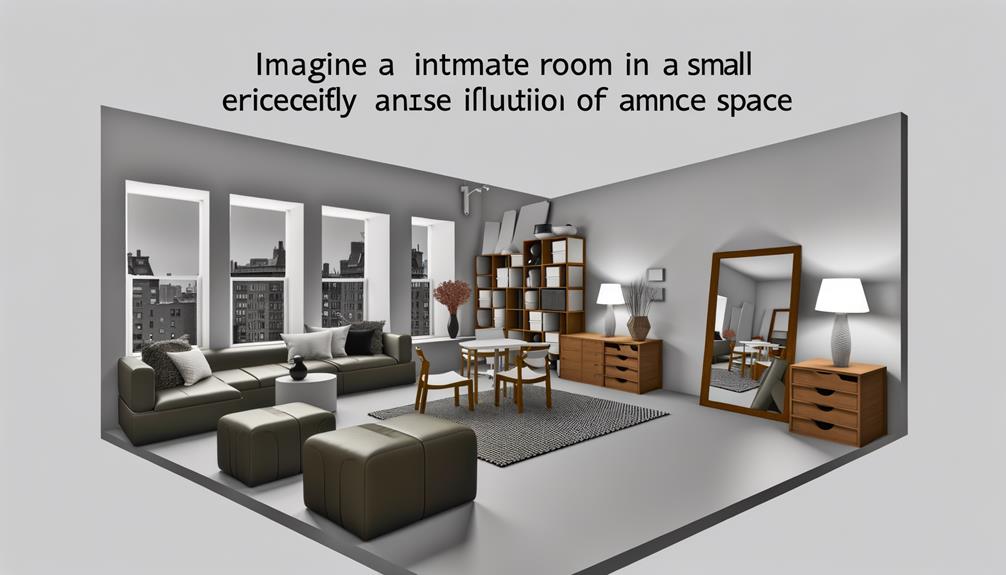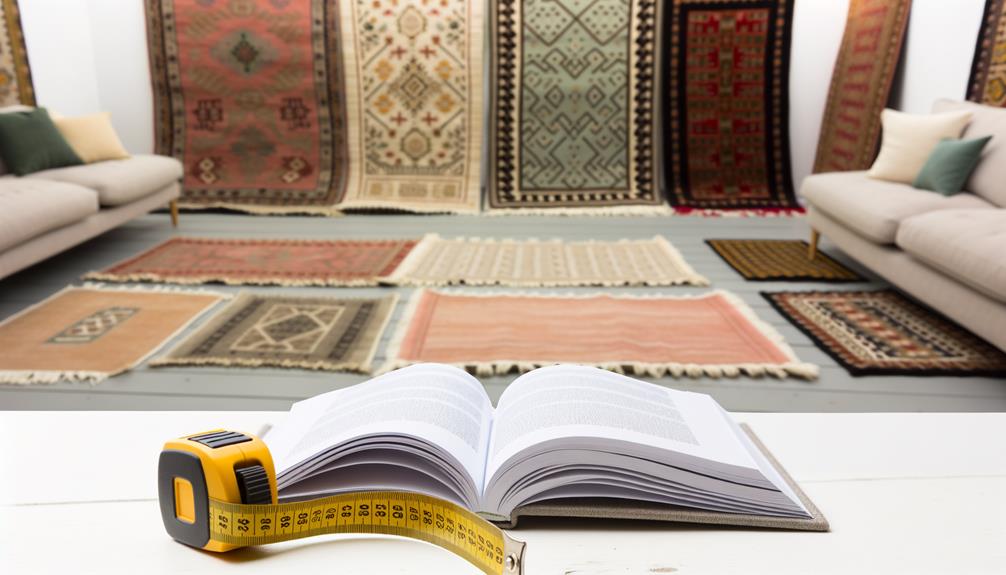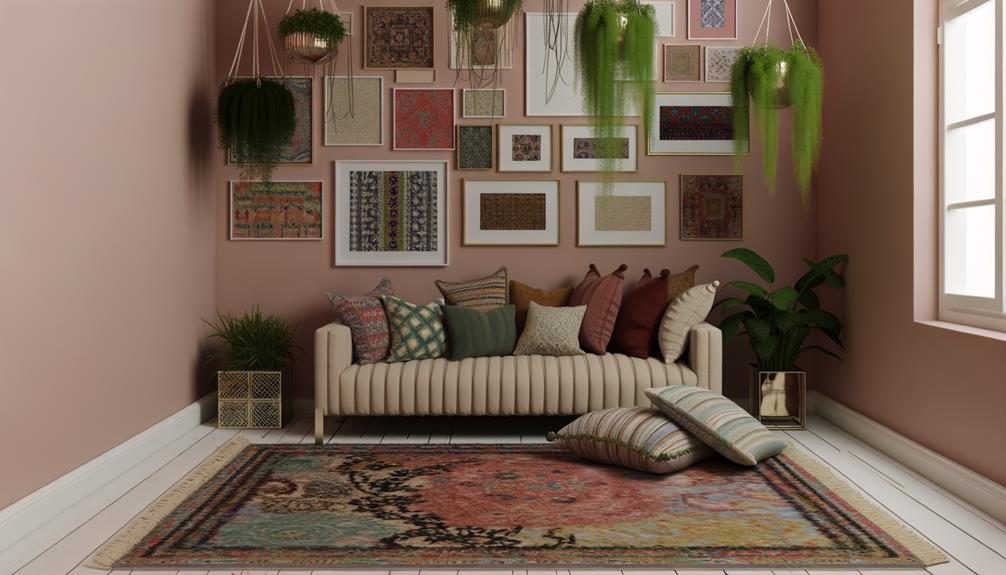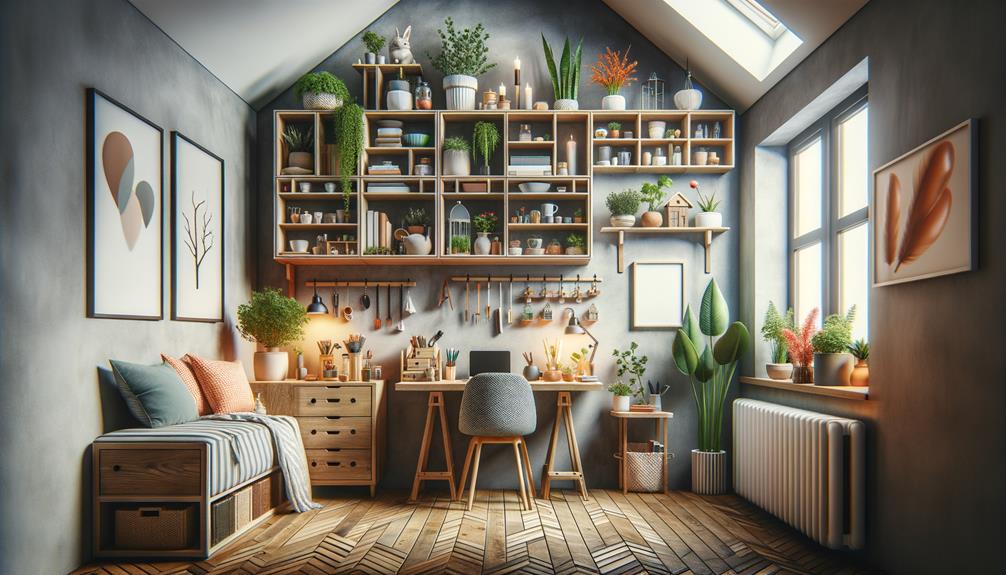You've got a small space and you're not quite sure how to make it feel bigger, brighter, and more functional. You're not alone. With clever use of multi-purpose furniture, light color schemes, and strategic placements, you can turn that tiny room into a cozy haven that seems larger than it truly is. Let's talk about how to enhance every inch of your small space, leaving no corner unattended. Stick around; there's more to this intriguing transformation than you might think.
Key Takeaways
- Utilize vertical spaces and corners with shelves and wall-mounted furniture for effective storage and organization.
- Opt for multi-purpose furniture and smart storage solutions to maximize functionality and space usage.
- Use light color schemes and mirrors to create an illusion of a larger, brighter room.
- Strategically place appropriately scaled furniture and wall art to enhance room aesthetics without overwhelming the space.
- Incorporate elements like open shelves, rugs, and stripes to add personality and define the area.
Embracing Vertical Spaces

Don't let your walls go to waste; instead, use them as a key asset in decorating your small space. Embracing vertical spaces is a smart way to maximize your small living area. You've got a lot of potential up there, so why not put it to good use?
Consider using shelves. They're a great way to keep things organized while making your space look more attractive. You can opt for floating shelves that don't take up much room, yet provide plenty of storage. Display your favorite books, plants, or pieces of art. They'll not only add personality to your space but also create a visual interest that draws the eye upward, giving an illusion of a bigger room.
Another idea is to use wall hooks. They're practical, stylish, and can hold anything from coats and bags to decorative items. You might even consider wall-mounted furniture, like a desk or a fold-down table. It's a clever way to save floor space.
The Magic of Mirrors

While maximizing your vertical space is an effective strategy, you can also harness the power of mirrors to make your small space seem larger. This isn't magic, but a simple trick of light and perception. Mirrors reflect light, both natural and artificial, and bounce it around the room, creating an illusion of depth and space.
Don't just hang a mirror anywhere, though. It's all about strategic placement. Think of where the light hits in your room and place your mirror to reflect it. You'll see an instant brightening effect.
Try leaning a large mirror against a wall. This can provide the illusion of depth, making the room appear longer or wider than it really is. Mirrors can also serve as a focal point in your room. For example, a beautiful ornate mirror can be much more than a practical essential; it can serve as a piece of art.
Functional Multi-purpose Furniture

In addition to utilizing mirrors, investing in functional multi-purpose furniture can dramatically enhance the usability of your small space. Imagine having a bed that converts into a desk during the day or a coffee table that offers storage space. You're not just acquiring furniture; you're acquiring options for organizing and managing your space.
Consider a sofa bed for your living area. It's a couch when you're entertaining and a bed when you need a place to crash. You'll save space, and you'll always be ready for unexpected guests. Nesting tables are another great option. You can spread them out when you need more surface area and tuck them away when you're done.
Light Color Scheme Benefits

Moving on from multi-purpose furniture, let's explore how a light color scheme can open up your small space even more. You'd be surprised at the impact of color on the perception of space.
Light colors, particularly whites and pastel hues, reflect light rather than absorb it. This simple property can make your small room appear larger and more spacious. It's almost like a visual trick, fooling your brain into thinking there's more space than there actually is.
But it's not just about making the room look bigger. It's also about the atmosphere. Light colors can make your room feel fresher, brighter, and more welcoming. They provide a peaceful and clean backdrop, allowing your furniture and decor to shine. You'll find it easier to relax and unwind in a space that feels open and airy.
Keep in mind, this doesn't mean your room has to look sterile or bland. You can still play with textures, patterns, and accents in your decor. Just remember, the key to maximizing a small space with a light color scheme is balance. Too much white can feel cold, but the right mix can create a room that's both cozy and spacious.
Strategic Furniture Placement

Let's shift our focus now to strategic furniture placement.
You'll be surprised how simple tweaks can maximize your room's functionality and achieve a visual balance.
Ready to learn how you can make the most out of your cozy space?
Maximizing Room Functionality
To maximize your room's functionality, strategically placing furniture can make a significant difference. Think about how you'll use the room and place furniture accordingly. For example, if it's a living area, position your sofa and chairs to promote conversation. In a small bedroom, consider a loft bed with a desk or storage underneath to save space.
Don't forget about corners. They're often overlooked, but can be ideal for a cozy reading nook or a small home office. Also, dual-purpose furniture like storage ottomans or a coffee table with drawers can provide extra storage without taking up more room.
Lastly, leave enough space for people to move around. If you can't easily walk through the room, it's not functional, no matter how well-organized it is.
Achieving Visual Balance
While you're working on functionality, it's equally important to create a visually balanced room through strategic furniture placement. Here's how you can achieve this:
- Symmetry: Position furniture in a way that mirrors itself across the room. It's not always about matching items, but more about creating harmonious lines and shapes.
- Focal point: Identify the main point of interest, whether it's a fireplace, artwork, or window. Arrange your furniture around this.
- Scale and proportion: Ensure your furniture fits the room size and complements each other in terms of proportions.
Maximizing Natural Light

Let's take a look at how you can maximize natural light in your small space.
The first step is to make the most of your window spaces.
Next, we'll explore how to use reflective surfaces and light color schemes to increase the brightness and openness of your room.
Utilizing Window Spaces
In small spaces, you can make the most out of your windows to maximize natural light, creating an illusion of a larger, more open area. Ensuring your windows are unobstructed is a simple yet effective way to brighten up your space.
Consider these ideas:
- Sheer Curtains: They allow sunlight to filter through while still maintaining privacy. You'll be surprised how much light they let in!
- Window Shelves: Placing plants or decor items on window shelves won't block light but adds visual interest.
- Light Colors: Opt for light-colored window trims and blinds. They reflect light and make your space seem larger.
Reflective Surfaces Usage
To further enhance the natural light in your small space, you can't go wrong with using reflective surfaces. Reflective surfaces could be anything from mirrors to glossy finished furniture, metallic décor, and shiny accessories. They work by bouncing light around the room, making it feel brighter and more spacious.
Consider placing a large mirror directly across your window to double the amount of sunlight entering the room. Even a series of smaller mirrors can create a big impact. Glossy or metallic furniture can also do the trick. These shiny pieces reflect light and add a touch of glamour to your space.
Reflective surfaces not only maximize natural light, but also add depth and dimension to your room.
Light Color Schemes
Building on the idea of maximizing natural light, choosing a light color scheme for your small space can further enhance brightness and create an illusion of more room. Light colors reflect more light, and this reflection can make a small room feel larger and more open.
Here are some ideas to consider:
- Stick with neutral colors: Whites, beiges, or light grays can open up a room, making it feel airy and spacious.
- Opt for pastel shades: Pastels are great for enhancing natural light and creating a soothing atmosphere.
- Use light wood or white furniture: This will maintain the light color scheme and contribute to the illusion of space.
Remember that it's not just about the walls; consider your furniture, floors, and accessories too.
Clever Storage Solutions

Often, you'll find that smart storage solutions are indispensable for decorating small spaces effectively. These aren't just practical, they can also add style and personality to your space.
Firstly, consider multipurpose furniture. Think ottomans that open up to reveal storage inside, or a coffee table with drawers. They're not only functional but also keep your knick-knacks out of sight, preventing clutter.
Next, think vertically. Don't just limit your storage to the floor. Use the walls as well. Wall-mounted hooks, magnetic strips, and pegboards can hold anything from utensils to keys. Also, consider over-the-door storage for shoes, accessories, or even pantry items.
Under-bed storage is another smart solution. You can use flat storage boxes or invest in a bed with built-in drawers. It's an excellent way to store seasonal clothing, bed linens, or things you don't use daily.
Lastly, don't forget about the corners. They're often overlooked but can be transformed into useful storage spaces with corner shelves or racks.
Open Shelving Wonders

Unleash the potential of your small space with open shelving, a design choice that's both functional and stylish. Open shelves present an easy way to organize your belongings while also offering endless opportunities for decoration. They're not just shelves, they're a canvas for your creativity.
Here's why you'll love open shelving:
- Versatility: Whether you're displaying books, plants, photos, or kitchenware, open shelves can handle it all. You're not limited to one type of item, making them a flexible storage solution.
- Space illusion: Open shelves create a sense of spaciousness in your room. By freeing up floor space and drawing the eye upwards, they make your room appear larger than it is.
- Easy access: No more rummaging through closed cupboards. With open shelving, everything you need is right there in plain sight. It's practical, efficient, and time-saving.
But remember, it's not just about piling things on. The magic of open shelving lies in thoughtful arrangement and styling. Mix and match items, play with colors, and let your personality shine through. You'll find that you can do wonders with open shelving in your small space.
Utilizing Corners Effectively

When it comes to small space decorating, don't overlook the potential of corners. Smart furniture choices, innovative storage solutions, and unique decoration techniques can transform these often neglected spaces.
Let's explore how you can turn your corners into functional, stylish areas of your home.
Corner Furniture Selections
You'll be surprised at how corner furniture can transform those underutilized nooks into functional and stylish spaces in your small home. Choosing the right pieces can make a world of difference.
Here are a few options to consider:
- Corner shelves: These are perfect for displaying your favorite trinkets or books. They're functional and they don't take up much space.
- Corner desks: This is a great option if you're working from home. It's a space saver and it'll give you a dedicated workspace.
- Corner cabinets: These are ideal for storing items that you want to keep out of sight. They're a stylish way to declutter your space.
Innovative Corner Storage Solutions
Building on the idea of corner furniture, let's explore some innovative corner storage solutions that can further enhance your small living space.
Ever thought about using corner shelves? They're a clever way to utilize unused space. You can store books, decorative items, or small plants there.
Corner cabinets are another great solution. They're perfect for storing larger items like clothes, dishes, or linens.
Want something more unique? Try a corner ladder! It adds a stylish touch while providing lots of storage.
Lastly, don't forget about corner hooks. They're ideal for hanging coats, hats, and bags.
Corner Decoration Techniques
Let's delve into the art of corner decoration, a technique that can dramatically transform your small space when utilized effectively. Corners, often overlooked, hold potential to enhance your room's aesthetic and functionality.
Here are a few corner decoration techniques you can apply:
- Floating Shelves: They're perfect for storing books, displaying photos or placing indoor plants.
- Corner Lighting: A floor lamp or hanging lights can add warmth and create a cozy reading nook.
- Wall Art: Hanging a piece of artwork or a mirror can make the corner a focal point.
Importance of Scale

Understanding the importance of scale in decorating small spaces can dramatically enhance the overall aesthetic and functionality of your room. It's a factor that shouldn't be overlooked. When you're selecting furniture or accessories, you need to consider their size in relation to the size of the room. If you choose items that are too large, they'll overwhelm your space and make it feel cramped. Conversely, if you opt for pieces that are too small, they'll appear lost and your room will lack cohesion.
Opting for Wall Arts

In small spaces, wall art isn't just decor—it's a strategic tool to add depth and create the illusion of a larger room. You're not limited to paintings or prints; consider tapestries, wall sculptures, or even a stylish clock. Don't be afraid to express your style and personality.
- *Go Vertical*: Exploit the height of your room by hanging art high on the wall. It'll draw eyes upwards, making the space seem taller than it really is.
- *Think Big*: One large piece can have a dramatic impact and eliminate the cluttered look that comes with too many small items.
- *Reflection*: Mirrored or metallic wall art can reflect light and add a sense of depth, tricking the eye into seeing more space.
But remember, balance is key. Don't overwhelm the space. You want the art to enhance the room, not dominate it. And don't forget to consider the color scheme. A well-chosen piece will complement the existing decor, tie the room together, and make your small space feel like a cozy, well-curated haven. Experiment and see what works best for you.
Rug Selection Tips

Moving on from wall art, it's time to lay the groundwork with the perfect rug for your small space. A rug can bring warmth and character while also defining your area. But remember, size matters. A rug that's too small can make the room look disjointed, while a large one can overwhelm the space. Aim for a size that fits comfortably within your seating area.
When picking colors and patterns, consider your room's palette. A rug with a bold pattern can liven up a simple space, but if your room already has a lot going on, opt for a rug with a subtle design or solid color.
Texture is just as important. A plush, high-pile rug can add coziness to a small living area, while a low-pile or flat-weave rug works best in high-traffic areas like the kitchen or hallway.
Lastly, don't shy away from shape. A round rug can soften a room full of angular furniture.
Choosing the right rug is about balancing style, function, and size. With these tips, you're sure to find a rug that not only fits your small space but also enhances it.
Illusion With Stripes

Stripes, whether on walls or furnishings, can dramatically alter your small space's perception, making it seem larger than it actually is. They're a nifty visual trick that you can use to your advantage. Here's how.
Vertical stripes can elongate your area, drawing the eye upwards and creating the illusion of higher ceilings. Consider striped wallpaper or a fresh coat of striped paint on your walls. Just remember to keep the colors light and the stripes thin to maintain a sense of spaciousness.
Horizontal stripes, on the other hand, can widen your room. Consider a striped rug or a piece of striped furniture. It's a subtle way to make the space feel more expansive.
You can even mix and match vertical and horizontal stripes for a dynamic twist. Experiment with different sizes and colors. Here are some tips to get you started:
- Stick to a unified color palette to keep your space cohesive.
- Try different stripe widths. Narrow stripes can add sophistication, while wider stripes can add a fun, bold statement.
- Don't overdo it. Too many stripes can make a room feel busy.
With a little creativity, you can master the illusion of space with stripes.
Room Divider Ideas

You've mastered stripes; now let's talk room dividers. You'll love exploring innovative designs that not only divide your space but also add to its aesthetic appeal.
But remember, while beauty is essential, choosing functional dividers that truly serve your space is key.
Innovative Divider Designs
There's a plethora of innovative divider designs that can transform your small space into a more functional and stylish living area. You're not limited to traditional screens or bookcases. Think outside the box and let your creativity flow.
- Curtains: Sheer curtains can create a soft, airy separation without completely cutting off one area from another. They're easy to install and won't overload your space.
- Plants: A vertical garden or a row of tall potted plants can divide your room naturally. Plus, they improve air quality and bring a touch of nature indoors.
- Art Display: Using a large artwork or a collection of smaller pieces can visually separate spaces while adding a personal touch.
With these innovative ideas, you'll make the most out of your small space.
Choosing Functional Dividers
When it comes to choosing functional room dividers, it's crucial to consider both style and practicality to maximize your small space. You want dividers that not only add a touch of elegance but also serve useful purposes.
Think about incorporating shelves into your dividers. They'll provide extra storage and display space, turning an otherwise simple divider into a multifunctional piece.
Opt for lightweight, movable dividers if you often rearrange your space. They're easy to handle and offer flexibility.
Glass panel dividers can let light flow through while still providing privacy. Remember, it's about balancing aesthetics and functionality.
Layering to Add Depth

In small spaces, smart layering can bring depth, creating an illusion of more room and adding a touch of style. It's about using design elements – colors, textures, lighting, and patterns – to create a visually appealing space that feels larger than it is.
Consider these layering techniques:
- Use Different Textures: Mix materials like metal, wood, fabric, and glass to create visual interest. This can make your space feel more expansive.
- Play with Colors: Use light shades for large items and deeper colors for accent pieces. This draws the eye around the room, making it seem bigger.
- Incorporate Lighting: Layered lighting, with a combination of ambient, task, and accent lights, can create depth and make your room appear larger.
Frequently Asked Questions
What Are Some Cost-Effective Small Space Decorating Ideas?
You're looking for budget-friendly decorating ideas for a compact area, right? Try using mirrors to enhance the space, multifunctional furniture for utility, and light colors to open up the room. Don't forget vertical storage options!
How Can Plants Contribute to Small Space Decor?
Plants breathe life into any room. They're not just cost-effective, but they also create an illusion of a larger space. Succulents, snake plants, and hanging plants are great options. They're easy to maintain and look stylish.
What Role Does Texture Play in Small Space Decorating?
Texture plays a vital role in your decorating scheme. It adds depth and interest, making your space feel larger. Use a variety of textures, like rough wood or soft fabrics, to create a visually appealing, layered look.
How Can Area Lighting Be Used Effectively in Small Spaces?
You can use area lighting effectively by positioning it to highlight key features. It'll create depth and interest, making the space appear larger. Also, consider layering light at different levels for an expansive feel.
Can a Minimalist Design Be Effective in Small Space Decorating?
Yes, minimalist design can be highly effective. It reduces clutter, makes the space appear larger, and emphasizes functionality. You'll find it's easier to keep tidy and it encourages thoughtful, essential purchases over impulse buying.
Conclusion
So, you've got small spaces to decorate? No worries! Maximize those inches by embracing vertical spaces, using mirrors, and placing furniture strategically.
Opt for multi-purpose pieces and light colors to enhance functionality and brightness. Don't forget about clever storage solutions or utilizing corners.
Consider scale, wall art, rug selection, and room dividers to add depth and personality. Remember, stripes can create the illusion of space too.
With these tips, your small space will feel larger in no time!







